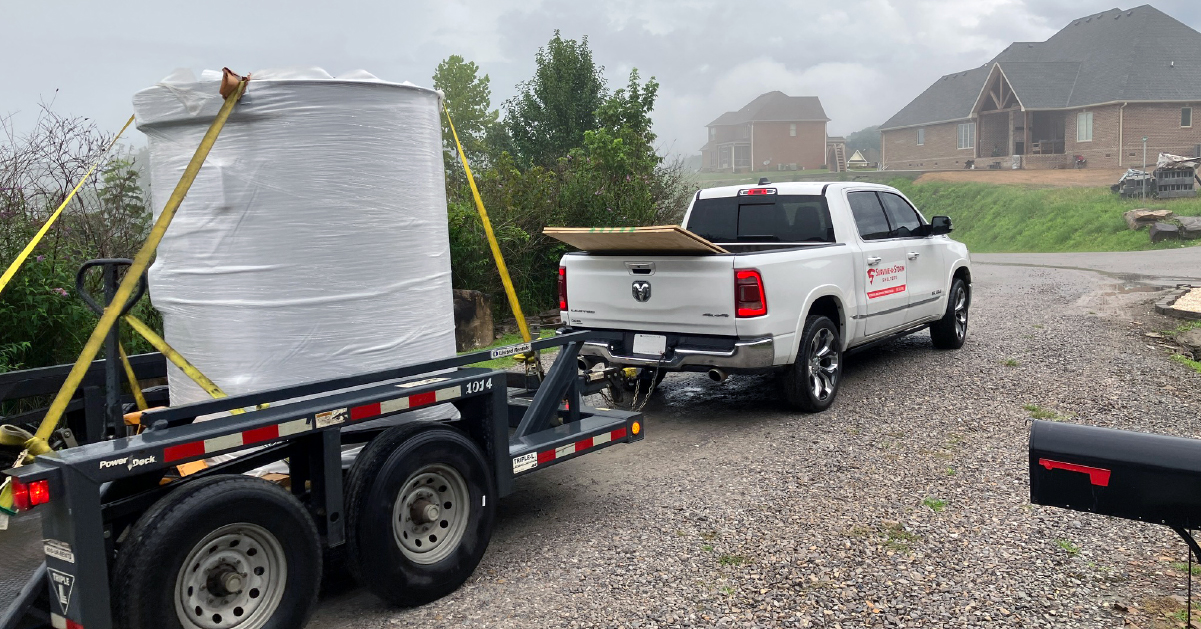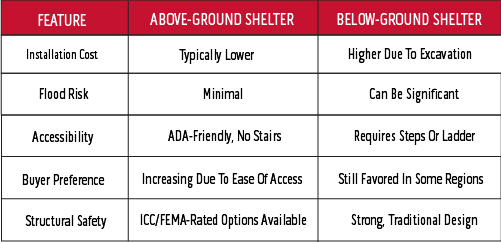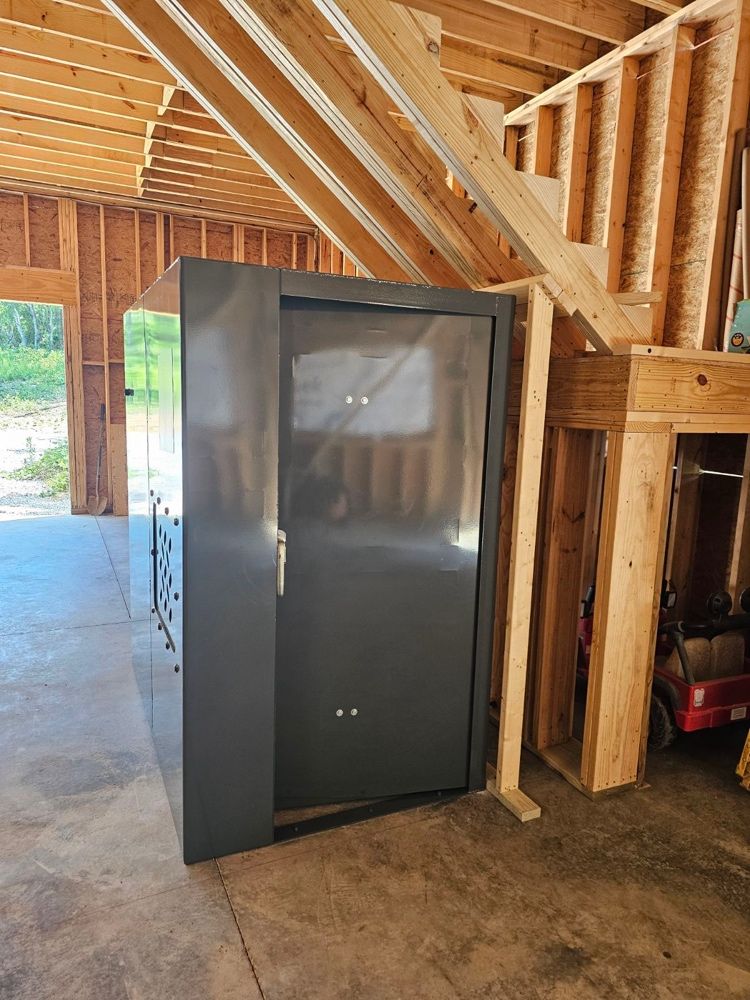CATEGORIES:
Best Tornado Shelter Options for New Construction Homes
August 22, 2025

Tornado Shelter Choices Have Changed
Here’s What Builders Miss
Tornado shelter technology and design have evolved significantly in recent years. While shelters were once viewed as bunker-style, utilitarian structures, today’s options are sleek, efficient, and can be seamlessly integrated into modern home plans. Yet, many builders and homeowners still think of them as costly, intrusive add-ons. This outdated perception leads to missed opportunities for value-added protection. If you're building a new home, understanding today’s shelter choices can mean the difference between installing a future-proof safety feature or retrofitting a solution later, at far greater expense.
Today’s shelters come in a variety of form factors, including steel panel shelters, below-ground concrete shelters, in-slab storm shelters, and closet-integrated designs. Each option has pros and cons depending on your home’s footprint, layout, and regional tornado risk profile. By learning what’s changed in shelter design, homebuilders and buyers alike can make better, safer, and more financially sound decisions.
What Makes a Shelter Right for New Construction?
 The best tornado shelter for a new build isn't just about safety; it’s about smart planning. During the construction phase, homeowners can choose from a broader set of shelter options that are easier and more cost-effective to install. Key factors to consider include:
The best tornado shelter for a new build isn't just about safety; it’s about smart planning. During the construction phase, homeowners can choose from a broader set of shelter options that are easier and more cost-effective to install. Key factors to consider include:
- Soil conditions and drainage (affects the feasibility of below-ground shelters)
- Lot size and layout
- Proximity to sleeping and living areas
- Local code and FEMA/ICC requirements
Shelters installed during new construction are more seamlessly integrated and are typically less expensive than retrofitting an existing structure. For example, the cost of excavation and framing is often reduced when done alongside other foundation work. Additionally, incorporating a shelter at the planning stage allows it to be included in the home’s design flow, making it easier to access and less visually disruptive.
Above vs. Below Ground: Which One Should You Choose?
Each shelter type offers distinct benefits. Below-ground shelters have long been seen as the gold standard, but modern above-ground shelters, especially those built to FEMA P-320 and ICC-500 specs, are just as secure. Which one is best for your new build?
Below-ground shelters are typically installed in garages or backyards and are less visually obtrusive. They’re also perceived as safer by many buyers, though they can present accessibility challenges for individuals with mobility limitations. Above-ground tornado shelters, on the other hand, are easier to access, especially for children, seniors, and individuals with disabilities. They're often placed inside interior closets, pantries, or dedicated utility rooms.

How Shelter Placement Impacts Design Flow and Safety Access
 Where you place the shelter affects both convenience and safety. Common integration points include:
Where you place the shelter affects both convenience and safety. Common integration points include:
- Garage (easy access, separate slab)
- Entry closets or interior pantries (discreet and central)
- Under stairwells or in safe room-converted bedrooms
The location of the shelter should allow for rapid access from anywhere in the home, particularly bedrooms and common living areas. During a tornado warning, families may only have a few minutes, or seconds, to reach shelter. Choosing a central location with minimal obstacles ensures everyone can move quickly and safely. Additionally, placing the shelter in an interior, windowless location reduces exposure to debris and wind pressure.
Custom vs Prefab: Which Style Matches Your Home and Values?
Prefab shelters are factory-built, code-compliant, and quick to install. Custom site-built shelters, on the other hand, offer seamless design integration and can match the finish, layout, and materials of the rest of your home.
A custom shelter can be designed to blend perfectly into the architecture of your new home, disguised as a walk-in closet, storage room, or utility space. These can be finished with drywall, flooring, and lighting that match the rest of the house. Prefab options are more modular and visible, offering convenience and lower upfront costs. Some models can be dropped into place in just a few hours.
Your choice will depend on your priorities: Is design cohesion important to you? Do you need to manage your budget tightly? Is timeline your biggest concern?
Trusted Materials and Certifications: What to Look For
Don’t cut corners on structural safety. Any tornado shelter you choose should meet or exceed:
- FEMA P-320 or P-361 guidelines (for residential shelters or community shelters)
- ICC-500 code (impact resistance, pressure testing, capacity)
- Local building code and permitting requirements
High-quality shelters typically feature reinforced steel or concrete walls, solid-core doors with three-point locking systems, ventilation systems, and anchoring capable of resisting uplift and lateral pressure. Verifying certifications with the National Storm Shelter Association (NSSA) ensures your shelter is engineered to perform when it matters most.
Frequently Asked Question about Tornado Shelter Options for New Construction Homes:
- Q. Are above-ground tornado shelters as safe as below-ground options?
- A. Yes, if they are built to ICC-500 and FEMA P-361 standards, both offer near-identical protection in EF-5 events.
- Q. Where should I place a shelter for fastest access during a storm?
- A. Ideally, in or near common living areas or bedrooms, like an interior closet, hallway, or garage. This tornado shelter placement will allow quick access for all family members.
- Q: What certifications should a tornado shelter have?
- A. Look for FEMA P-320 or P-361 (depending on size), ICC-500 compliance, and ideally, a manufacturer who follows NSSA guidelines.
- Q. Can tornado shelters be used as hurricane shelters or for other weather events?
- A. Tornado shelters are specifically engineered to meet safety standards for extreme wind events like tornadoes, especially under FEMA P-320, P-361, and ICC-500. While some may offer protection during hurricanes or other weather conditions, they are not designed or marketed as hurricane shelters. Flooding risk is also a key factor, especially for below-ground models. Always consult the manufacturer about your region’s weather threats before relying on any shelter for dual-purpose use.
What Would Homeowners Do Differently?
Wishing that they’d planned for it from the start is a common sentiment from homeowners who face a retrofit after moving into a new home. Waiting can mean:
- Higher costs due to demolition or rework
- Limited space or location options
- Delayed installation times during storm season
In contrast, homeowners who include storm shelters during construction report higher satisfaction and peace of mind. They’re often pleasantly surprised by how unobtrusive shelters can be and how easy it is to incorporate them into everyday spaces.
The Shelter Decision Checklist: Feel Confident Before You Build
Before finalizing your new home design, run through this simple checklist:
- Have I assessed my property’s tornado risk zone?
- Do local codes or lenders require a certified shelter?
- Do I want above- or below-ground shelter access?
- Have I chosen a shelter location that’s both safe and accessible?
- Is the shelter built to comply with ICC-500 and FEMA standards?
- Have I budgeted appropriately for installation during construction?
By planning now, you’ll avoid stress later and make a long-term investment in safety, peace of mind, and property value. Investing in a tornado shelter during new construction is a wise choice and a proactive step toward building a safer, more resilient future for you and your family.
Additional Considerations: Matching Shelter Features to Your Needs
Every family, home, and location is different. When evaluating tornado shelter options, it's important to match specific features to your personal needs, property layout, and budget. Here are a few extra considerations that can help you make the right decision:
-
Shelter Sizes & Types: Shelters come in a range of sizes to fit different family numbers, from compact units to large-capacity safe rooms. Common types include above-ground steel shelters, below-ground concrete shelters, and fiberglass models.
-
Materials & Durability: Steel and concrete are the most trusted materials, but some fiberglass shelters offer lightweight alternatives. All materials should be tested to withstand extreme winds, water infiltration, and flying debris. Be aware of potential leaks or damage over time.
-
Entrance & Accessibility: Your shelter entrance should allow quick, safe access during storms. Consider how family members of all ages and abilities will reach it. Placement near the garage or along a concrete slab walkway can add convenience.
-
Home Design Fit: If you have a basement, the shelter may be placed there. But, that isn’t always ideal depending on water table levels. For homes without basements, garage or first-floor closet options may work better.
-
Security & Storage: Some families choose to store valuables or emergency supplies in their shelter. Check for lockable doors, ventilation, and moisture resistance. Make sure storage doesn't block entry or become cluttered over time.
-
Company & Craftsmanship: Not all companies build shelters to the same standards. Look for a manufacturer with a trusted team, strong customer support, transparent pricing, and verified safety standards. Membership in the NSSA is another indicator of quality and compliance. Ask questions, compare prices, and make sure delivery timelines fit your construction schedule.
-
Peace of Mind: The right shelter provides comfort during a storm, not just physical protection. It should meet your safety preferences while supporting your daily life and family routines.
Adding a tornado shelter during new construction means you're protecting more than just a structure. You'll be protecting lives, valuables, and future peace of mind.
Talk with a shelter expert.







